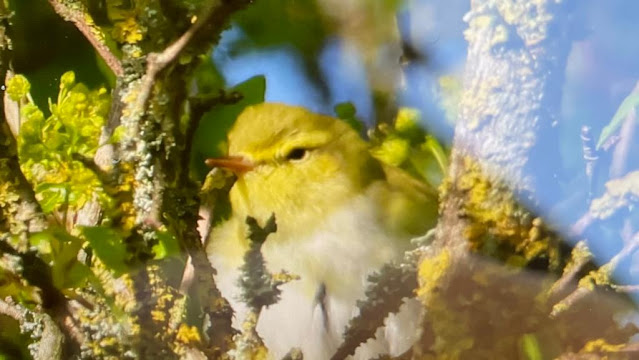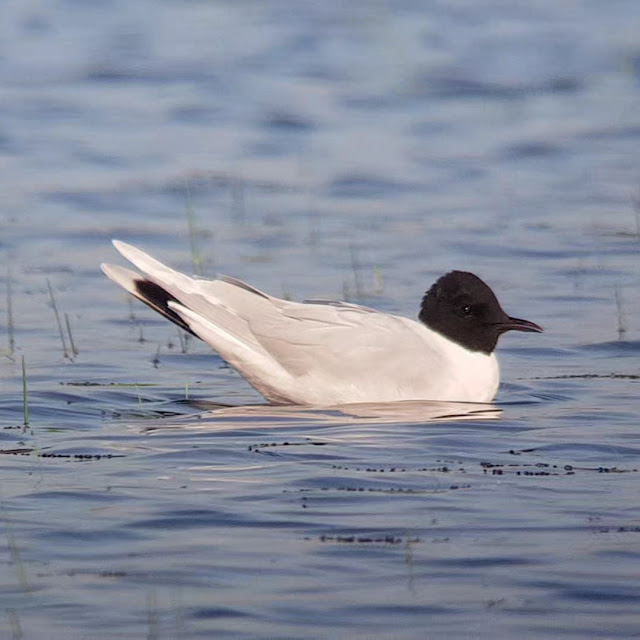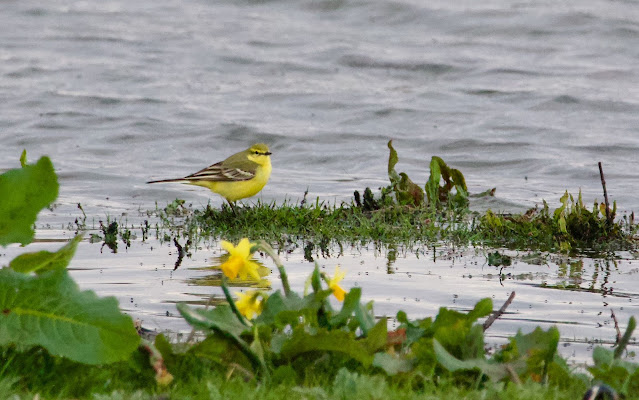So we've come to the end of what is probably the most exciting month of the year in terms of year ticks and variety. Fortunately, this year April certainly lived up to expectations with a superb month of all sorts of goodies. What's more, the time since my last post certainly pulled its weight in terms of contributions.
Starting with waders, there has been a bit of slow down this last week or so as we move past the peak passage time. We had up to 7 Dunlin and a few Ringed Plover pass through though I think the lack of shoreline isn't really suiting the smaller species much. In any event they are currently harder to see because of all the vegetation cover. We finally got Ruff on the year list with a female that spent a day on the floods. We had a few Common Sandpipers at last with up to 6 recorded on one day. A Wood Sandpiper put in a brief appearance on the 28th though only stayed about half an hour. A Greenshank dropped in for a few hours one day. Finally today we had a couple of Whimbrel fly over calling so that got onto the year list as well.
On the duck front, we had a few more Garganey turn up and stay for a few days since my last post. Estimates are that we've had up to 9 individuals now this spring! Apart from this there has been little else to report with almost all the winter duck now gone. There are some lingering Gadwall still and we've still had up to 9 Shelduck and up to 3 Egyptian Geese but little else of note.
What we've lacked on the duck front we've more than made up for with Warblers. We have to start with an absolutely stellar find in the form of a singing male Wood Warbler. This was found on the 24th in Burgess Field by a visiting European birder who didn't know the English name for it. Fortunately Thomas Miller was on hand to check it out. Sadly it didn't linger long enough for more than the most quick off the mark locals to twitch it and there was no further sign that day. However the next day, remarkably it was found again still singing in a slightly different place. Once again it soon stopped singing after which it became almost impossible to locate. However the bird may have relocated to Wytham as a singing male has subsequently been found there and has stayed several days already. Our star bird was only the second ever on the patch to my knowledge after a single observer record a couple of years ago. Just to add icing on the cake, another singing male was reported along the canal by the back of Worcester College gardens near the lock one day though there was no subsequent reports or sightings of this bird.
 |
| The Wood Warbler courtesy of Pete Roby |
 |
| The Wood Warbler courtesy of Ben Sheldon |
Apart from this the other warblers that we might expect duly turned up with Reed Warbler, Lesser Whitethroat, Garden Warbler and Sedge Warbler all being seen. Indeed it's been a rather good spring for the latter species which is normally rather hard to record in the patch. There have been at least 5 records already this month alone. This also applies to Willow Warbler: I don't think I ever remember so many records of this species passing through on the patch. I'm not quite sure why this should be but it's very welcome all the same.
There was some more hot Tern action this week when 6 Arctic Terns flew through. Added to this Thomas Miller had an outrageous garden tick when a Sandwich Tern flew over his house in Abbey Road, just south of the Meadow. Apart from that, there have been regular Common Tern sightings all week. Nothing to report on the gull front apart from a 1st summer Mediterranean Gull in amongst the lingering Black-headed Gulls one evening.
The first summer Med Gull
In terms of other sightings, a male Redstart was spotted in
Burgess Field one evening though didn't linger. We had a couple of
fly-over Great White Egret sightings as well. There have been several
calling Cuckoo records in Burgess Field.
 |
| The Redstart |
The first Hobby of the year was seen over the Meadow. We've had some more Yellow Wagtails (up to 20) hiding away in the long vegetation on the river side of the floods. Finally a Wheatear was seen in the Hinterland this week - I can't help but wonder how many of these we are missing as this area is birded far less often.
 |
| Hobby courtesy of Matthew Lloyd |
Looking ahead, we've already amassed a pretty reasonable year list total and it's only the end of April! However, this does mean that there is not much "low hanging fruit" left in terms of year ticks. Glossy Ibis, Spotted Flycatcher, Whinchat, Tree Pipit, Knot and Sanderling are the main ones which spring to mind. I also can't help but wonder about Spoonbill which used to be a bit of a patch speciality back in the day. Of course May is also the peak month for rarities in the first half of the year so something much juicier could always turn up. Let's hope so!






